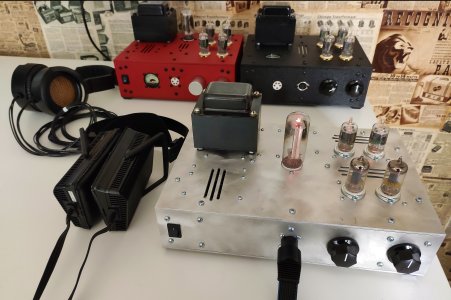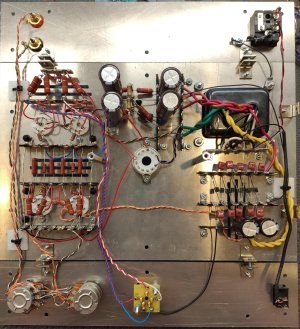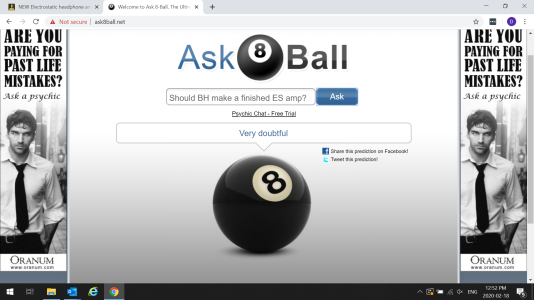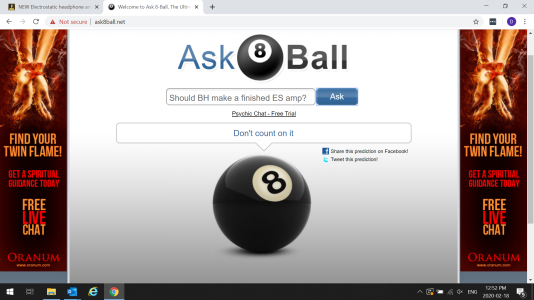PB has been working on an ES headphone amp for a few months now. The ES project was something I had in the back of my head for several years, but it just never floated to the top of the development pile. A few months back Sajeev Ranasinghe of Nectar Sound contacted me asking if we had plans to do an ES headphone amp, and after some conversation he sent a demo pair of his very interesting headphones for us to listen too. http://www.nectarsound.net/?i=1
So once the development backlog was clear PB set about building up a direct drive headphone amp design. The circuit is a single ended input running into a two stage differential amp using the very linear 5965s and it features a bias supply high enough to run the Nectar Sounds, which require a 500-700V bias supply and can be had with the same 5 pin plug used on the Stax "professional" series. The nice thing about the Nectar Sound bias requirement is that the 580V bias requirement of Stax professional headphone models fits in the same range, so he set about cooking up a 580V supply for both brands of cans and we can also derive the 230V bias voltage of the older Stax cans as well. With the two styles of jacks (5 pin "pro", 6 pin original) that Stax uses available on the front and with the appropriate bias voltage assigned to each one, one could have an amp that will run the Nectar Sounds and any Stax ES headphone too.
We have three evolutionary prototypes in house and we have listened to Nectar Sound, Stax and Koss ES headphones. They all work as expected. The chassis has taken a turn away from our usual flat panel in wood base approach. The bias voltage supply, while operating at a teeny current, is high enough voltage-wise that we felt it made sense to completely enclose the circuit in metal. PB designed the layout so that it could be done as a kit. It would be a pretty involved build with a lot of sub assemblies to build and test. We're spitballing the kit price at around $800-900. If we deliver the amp as a finished product we are probably looking at $1200+.
The audience here is of course heavily biased (pardon the pun) towards kit building. We wanted to get some feedback on whether there may interest in our offering this as a finished product rather than a kit, considering the reasonably high skill level required for assembly. We'd like to hear your preference in this thread.
So once the development backlog was clear PB set about building up a direct drive headphone amp design. The circuit is a single ended input running into a two stage differential amp using the very linear 5965s and it features a bias supply high enough to run the Nectar Sounds, which require a 500-700V bias supply and can be had with the same 5 pin plug used on the Stax "professional" series. The nice thing about the Nectar Sound bias requirement is that the 580V bias requirement of Stax professional headphone models fits in the same range, so he set about cooking up a 580V supply for both brands of cans and we can also derive the 230V bias voltage of the older Stax cans as well. With the two styles of jacks (5 pin "pro", 6 pin original) that Stax uses available on the front and with the appropriate bias voltage assigned to each one, one could have an amp that will run the Nectar Sounds and any Stax ES headphone too.
We have three evolutionary prototypes in house and we have listened to Nectar Sound, Stax and Koss ES headphones. They all work as expected. The chassis has taken a turn away from our usual flat panel in wood base approach. The bias voltage supply, while operating at a teeny current, is high enough voltage-wise that we felt it made sense to completely enclose the circuit in metal. PB designed the layout so that it could be done as a kit. It would be a pretty involved build with a lot of sub assemblies to build and test. We're spitballing the kit price at around $800-900. If we deliver the amp as a finished product we are probably looking at $1200+.
The audience here is of course heavily biased (pardon the pun) towards kit building. We wanted to get some feedback on whether there may interest in our offering this as a finished product rather than a kit, considering the reasonably high skill level required for assembly. We'd like to hear your preference in this thread.




